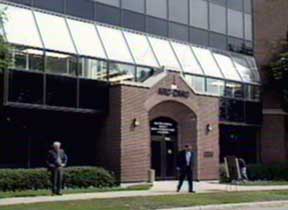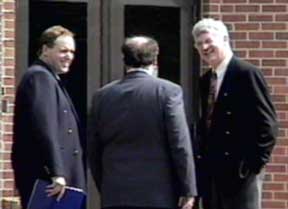 |
|
| FTLComm - Saskatoon - July 2, 2000 | |
| Friday morning the National Research Council held a press conference at their building at the University of Saskatchewan in Saskatoon to announce the construction of a fifteen million dollar expansion to a bio-technical building on campus. All but one million of this money will come from the federal government | |
The continued development of research facilities on the University of Saskatchewan campus is most remarkable and given the present and continuing circumstances regarding the university's research efforts, is more than a little puzzling. To many, funding research in Saskatoon would be similar to offering one additional life boat to the White Star line to be included on their new 1912 ocean liner. The mounting suspicion and declining reputation of work done by this University has reached the point where one must view with pity any and all individuals who invested their money and efforts to get their degree from the University of Saskatchewan. To understand the situation you must come to some reckoning with what the concept of University really means |
 |
| and with that in mind understand how much is jeopardised by a centre for higher learning getting themselves involved in questionable financial strings to academic activity. Universities and colleges are at the mercy of public perception and opinion. | |
The public, the business community and other universities judge the performance of an institution with extremely subjective and whimsical standards. The quality and achievements of graduating students, the scholarly and substantive depth of the courses offered, the nature and reputation of the research associated with the institution, all of these factors are taken into consideration and out of them comes shared opinion on the relative value of the place when compared to other similar institutions. The University of Saskatchewan when ranked by McLeans magazine was placed as number fourteen out of a field of fifteen. One can dispute the merit of the ranking and argue that this is hardly the real litmus test of quality, but you are reminded that the subjective and imprecise ranking of a university is only refuted by delivering solid widely |
 |
| recognised evidence that the place is on the mend and getting better and better. | |
Almost everyone who has seen a movie or even held a casual conversation about what constitutes a good education knows about places like Cambridge, Eaton, Harvard, Yale, McGill, West Point, Vassal, Berkeley, John Hopkins, MIT, St. Xavier, Chapel Hill and no doubt you would add others. These places brand their students with their reputation and the aura of their excellence. In a group of Canadians with post secondary degrees, a person wearing a ring with a black "X" on it is respected and treated with guarded authenticity without that person saying or doing anything. That small but outstanding college turns out capable individuals who can think on their feet and make an argument stick. We may view Brian Mulroney with disdain but everyone respects that ring on his finger and what that means about his background and training. |
 |
| An educational institution must guard its reputation more than any other element that makes up the university. The facilities, its buildings, its library, the level of training of its faculty, all are trivial compared to its achievements and the perception of it by other institutions and the public and that includes the press as they reflect the opinions of many. The really important part of this sort of thing is that the university must guard itself, not defend itself. Guarding an institution means that rules and precedent is established and followed to prevent anything from casting even minor doubt on the quality of work done there. Academic freedom is protected and worshipped like a religion and the influence of government, business and vested interest groups is considered the poison that will destroy the well of knowledge. |
 |
| Ensign has obtained this article written by Barry McLennan the assistant dean of research in the college of medicine at the University of Saskatchewan. The material is shown here on the right or you can click here, to see the document as a full |
|
| page. This is a defense Dr. McLennan goes through the Cassidy saga defending the University's position, arguing that emotional arguments rather than science are being used to sully the research and researcher. This is a sad and pitiful attempt because even if he is right the obvious and widely demonstrated judgmental errors made by the University in this and other projects |
|
| makes it utterly impossible to sway an opinion to the contrary. In the man's third and fourth paragraphs he explains how the University maintains its academic integrity when a quick click to a University web site shows that the vice president to the Administrative Committee of the study is a company man, Jon Schubert from SGI. McLennan shamelessly attacks Dr. Ken Yong-Hing whom the university replaced with Dr. Cassidy while four years ago Dr. Ken Yong-Hing states "differences arose over SGI personnel's interference in the research work." and "I feel that SGI's interference in the research will expose the results and conclusions of the study, when they are published." Perhaps the most offensive part of Dr. McLennan's statement is that "the manner in which this study and those involved in it, have been so unprofessionally criticized in public forums |
|
| and the press." Nobody ever said maintaining your reputation is "fair". If you, as an institution, cross the line, take money from a company to give them favourable research results, your reputation and all that you are is a grease mark on the educational parking lot. The merits of the Cassidy research has been attacked in Ensign and every other form of media, simply because basing medical research upon wh  en a claim file is closed is quite simply foolishness. Cassidy, his research team, the University and the New England medical journal deserve to be called "stupid" for allowing themselves to endorse a procedure that no kid working on a grade six science fair project would ever try. Imagine your belief in the validity of your eleven year old explaining that he timed when eggs were cooked by when his mother turned off the light in the kitchen. When SGI closed the file Cassidy claimed the victim cured. He did not do this a few times, it was the method he used to measure the entire 1.5 million dollar project. en a claim file is closed is quite simply foolishness. Cassidy, his research team, the University and the New England medical journal deserve to be called "stupid" for allowing themselves to endorse a procedure that no kid working on a grade six science fair project would ever try. Imagine your belief in the validity of your eleven year old explaining that he timed when eggs were cooked by when his mother turned off the light in the kitchen. When SGI closed the file Cassidy claimed the victim cured. He did not do this a few times, it was the method he used to measure the entire 1.5 million dollar project.On Friday as the University and the Canada Research Council announced their newest development and as I met a young woman working on her masters degree doing bio-research, I really felt bad. Both the CRC and the young woman are investing their time and money, and definitely for the young woman, her future, on the University of Saskatchewan. When the young woman gets her degree will it evoke snickers when she applies for a job? Will research in the new wing funded by the Research Council be disregarded by other research centres because it came from Saskatoon, the second last ranking university in Canada, the one where they do research by measuring successful medical cures by when a bureaucrat closes a file? Reputations are fragile things based on the last piece of work done and only recovered by good solid trusted work not by attacking researchers who quit projects because of company interference, or claiming that " Emotional public debate having no factual foundations simply does not assist in the search for the answer." My condolences to all of you who have the words "University of Saskatchewan" on your bachelors degree or your masters, doctorate, or diploma. Sorry to hear that. The president's wife is in the provincial cabinet. The place and its reputation are worth about the same amount as stock in the Saskatchewan Wheat Pool. Timothy W. Shire |
|